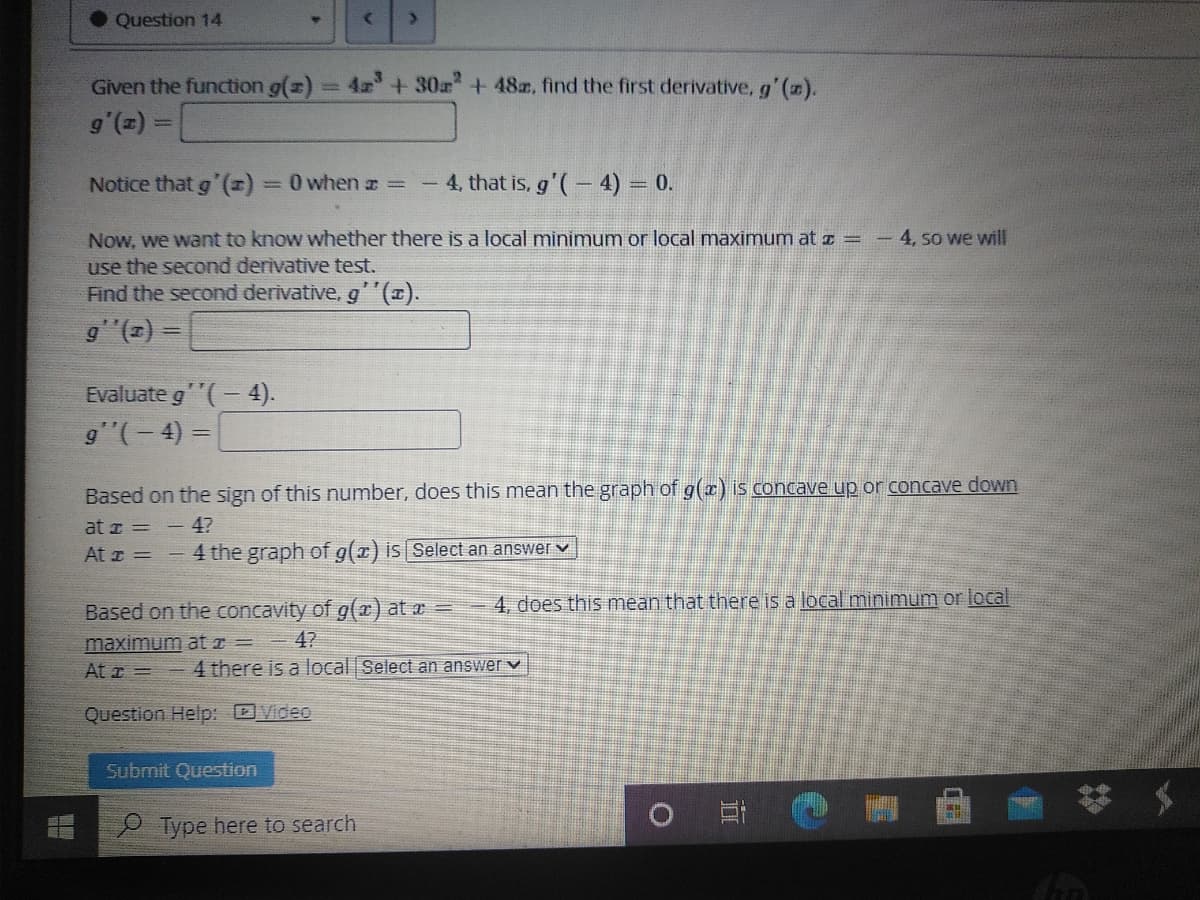Given the function g() 4 + 30a+ 48z, find the first derivative, g' (#). g'(z) = Notice that g'(): = 0 when = -4, that is, g'(-4) = 0. Now, we want to know whether there is a local minimum or local maximum at z = 4, so we will use the second derivative test. Find the second derivative, g''(I). %3D Evaluate g'(-4). g"(-4) = Based on the sign of this number, does this mean the graph of g(x) is concave up or concave down at I = - 4? At z = – 4 the graph of g(x) is Select an answer v Based on the concavity of g(x) at a = 4, does this mean that there is a local minimum or local maximum at z = 47? At r = 4 there is a local Select an answer v Question Help: DVideo Submit Question P Type here to search
Given the function g() 4 + 30a+ 48z, find the first derivative, g' (#). g'(z) = Notice that g'(): = 0 when = -4, that is, g'(-4) = 0. Now, we want to know whether there is a local minimum or local maximum at z = 4, so we will use the second derivative test. Find the second derivative, g''(I). %3D Evaluate g'(-4). g"(-4) = Based on the sign of this number, does this mean the graph of g(x) is concave up or concave down at I = - 4? At z = – 4 the graph of g(x) is Select an answer v Based on the concavity of g(x) at a = 4, does this mean that there is a local minimum or local maximum at z = 47? At r = 4 there is a local Select an answer v Question Help: DVideo Submit Question P Type here to search
Algebra & Trigonometry with Analytic Geometry
13th Edition
ISBN:9781133382119
Author:Swokowski
Publisher:Swokowski
Chapter5: Inverse, Exponential, And Logarithmic Functions
Section5.3: The Natural Exponential Function
Problem 56E
Related questions
Question
Math help

Transcribed Image Text:Question 14
Given the function g(x)
4+ 30a+48z, find the first derivative, g'().
g'(=) =
Notice that g'()
=0 when I =
- 4, that is, g'(- 4) = 0.
Now, we want to know whether there is a local minimum or local maximum at z =
use the second derivative test.
Find the second derivative, g''(x).
- 4, so we will
Evaluate g"(-4).
g"(-4) =
Based on the sign of this number, does this mean the graph of g(x) is concave up or concave down
at I =
- 4?
At z = - 4 the graph of g(r) is Select an answer v
Based on the concavity of g() at a =
4, does this mean that there is a local minimum or local
maximum at z == 4?
At r ==
4 there is a local Select an answer v
Question Help: DVideo
Submit Question
Type here to search
Expert Solution
This question has been solved!
Explore an expertly crafted, step-by-step solution for a thorough understanding of key concepts.
Step by step
Solved in 2 steps with 2 images

Recommended textbooks for you

Algebra & Trigonometry with Analytic Geometry
Algebra
ISBN:
9781133382119
Author:
Swokowski
Publisher:
Cengage

Algebra & Trigonometry with Analytic Geometry
Algebra
ISBN:
9781133382119
Author:
Swokowski
Publisher:
Cengage